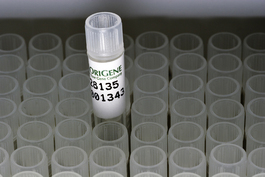LIMPII (SCARB2) (NM_001204255) Human Untagged Clone
CAT#: SC331529
SCARB2 (untagged) - Homo sapiens scavenger receptor class B, member 2 (SCARB2), transcript variant 2
"NM_001204255" in other vectors (2)
Product Images

Other products for "SCARB2"
Specifications
| Product Data | |
| Type | Human Untagged Clone |
| Tag | Tag Free |
| Symbol | SCARB2 |
| Synonyms | AMRF; CD36L2; EPM4; HLGP85; LGP85; LIMP-2; LIMPII; SR-BII |
| Vector | pCMV6 series |
| Sequence Data |
>NCBI ORF sequence for NM_001204255, the custom clone sequence may differ by one or more nucleotides
ATGGGCCGATGCTGCTTCTACACGGCGGGGACGTTGTCCCTGCTCCTGCTGGTGACCAGCGTCACGCTGC TGGTGGCCCGGGTCTTCCAGAAGGCTGTAGACCAGAGTATCGAGAAGAAAATTGTGTTAAGGAATGGTAC TGAGGCATTTGACTCCTGGGAGAAGCCCCCTCTGCCTGTGTATACTCAGTTCTATTTCTTCAATGTCACC AATCCAGAGGAGATCCTCAGAGGGGAGACCCCTCGGGTGGAAGAAGTGGGGCCATACACCTACAGGTCAC TTGACTGGTGGATAACAGACAAGTGCAATATGATTAATGGAACAGATGGAGATTCTTTTCACCCACTAAT AACCAAAGATGAGGTCCTTTATGTCTTCCCATCTGACTTTTGCAGGTCAGTGTATATTACTTTCAGTGAC TATGAGAGTGTACAGGGACTGCCTGCCTTTCGGTATAAAGTTCCTGCAGAAATATTAGCCAATACGTCAG ACAATGCCGGCTTCTGTATACCTGAGGGAAACTGCCTGGGCTCAGGAGTTCTGAATGTCAGCATCTGCAA GAATGGTGCACCCATCATTATGTCTTTCCCACACTTTTACCAAGCAGATGAGAGGTTTGTTTCTGCCATA GAAGGCATGCACCCAAATCAGGAAGACCATGAGACATTTGTGGACATTAATCCTTTGACTGGAATAATCC TAAAAGCAGCCAAGAGGTTCCAAATCAACATTTATGTCAAAAAATTAGATGACTTTGTTGAAACGGGAGA CATTAGAACCATGGTTTTCCCAGTGATGTACCTCAATGAGAGTGTTCACATTGATAAAGAGACGGCGAGT CGACTGAAGTCTATGATTAACACTACTTTGATCATCACCAACATACCCTACATCATCATGGCGCTGGGTG TGTTCTTTGGTTTGGTTTTTACCTGGCTTGCATGCAAAGGACAGGGATCCATGGATGAGGGAACAGCGGA TGAAAGAGCACCCCTCATTCGAACCTAA |
| Restriction Sites | SgfI-MluI |
| ACCN | NM_001204255 |
| OTI Disclaimer | Our molecular clone sequence data has been matched to the reference identifier above as a point of reference. Note that the complete sequence of our molecular clones may differ from the sequence published for this corresponding reference, e.g., by representing an alternative RNA splicing form or single nucleotide polymorphism (SNP). |
| Product Components | The cDNA clone is shipped in a 2-D bar-coded Matrix tube as dried plasmid DNA. The package also includes 100 pmols of both the corresponding 5' and 3' vector primers in separate vials. Every lot of primer is tested to provide clean sequencing of OriGene TrueClones. |
| Reconstitution | 1. Centrifuge at 5,000xg for 5min. 2. Carefully open the tube and add 100ul of sterile water to dissolve the DNA. 3. Close the tube and incubate for 10 minutes at room temperature. 4. Briefly vortex the tube and then do a quick spin (less than 5000xg) to concentrate the liquid at the bottom. 5. Store the suspended plasmid at -20°C. The DNA is stable for at least one year from date of shipping when stored at -20°C. |
| Reference Data | |
| RefSeq | NM_001204255.1, NP_001191184.1 |
| RefSeq Size | 4340 bp |
| RefSeq ORF | 1008 bp |
| Locus ID | 950 |
| Cytogenetics | 4q21.1 |
| Protein Families | Druggable Genome, Transmembrane |
| Protein Pathways | Lysosome |
| Gene Summary | 'The protein encoded by this gene is a type III glycoprotein that is located primarily in limiting membranes of lysosomes and endosomes. Earlier studies in mice and rat suggested that this protein may participate in membrane transportation and the reorganization of endosomal/lysosomal compartment. The protein deficiency in mice was reported to impair cell membrane transport processes and cause pelvic junction obstruction, deafness, and peripheral neuropathy. Further studies in human showed that this protein is a ubiquitously expressed protein and that it is involved in the pathogenesis of HFMD (hand, foot, and mouth disease) caused by enterovirus-71 and possibly by coxsackievirus A16. Mutations in this gene caused an autosomal recessive progressive myoclonic epilepsy-4 (EPM4), also known as action myoclonus-renal failure syndrome (AMRF). Alternatively spliced transcript variants encoding different isoforms have been found for this gene.[provided by RefSeq, Feb 2011]' Transcript Variant: This variant (2) lacks three consecutive exons in the CDS, as compared to variant 1. The reading frame is not affected and the resulting isoform (2) lacks an internal segment, as compared to isoform 1. Sequence Note: This RefSeq record was created from transcript and genomic sequence data to make the sequence consistent with the reference genome assembly. The genomic coordinates used for the transcript record were based on transcript alignments. |
Documents
| Product Manuals |
| FAQs |
Resources
{0} Product Review(s)
0 Product Review(s)
Submit review
Be the first one to submit a review
Product Citations
*Delivery time may vary from web posted schedule. Occasional delays may occur due to unforeseen
complexities in the preparation of your product. International customers may expect an additional 1-2 weeks
in shipping.






























































































































































































































































 Germany
Germany
 Japan
Japan
 United Kingdom
United Kingdom
 China
China
